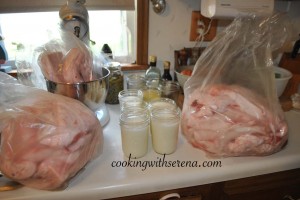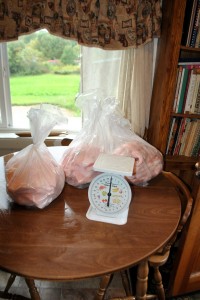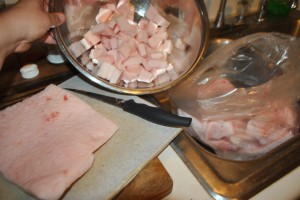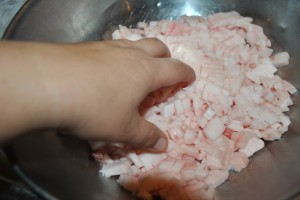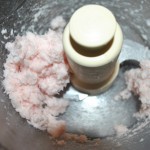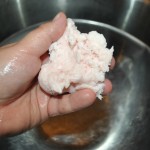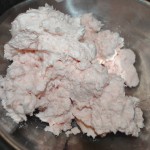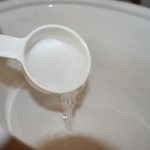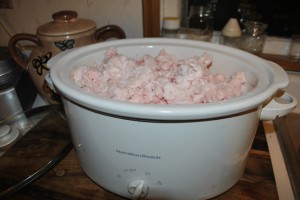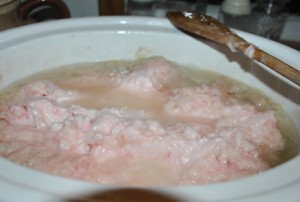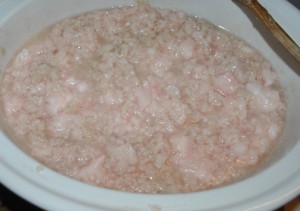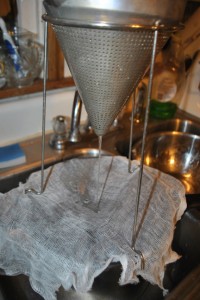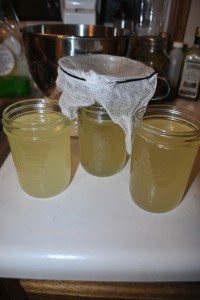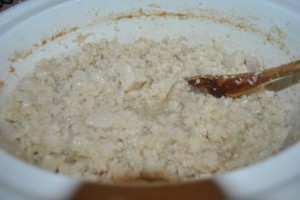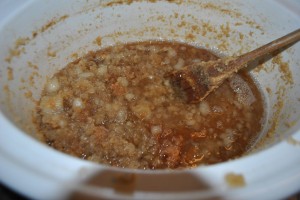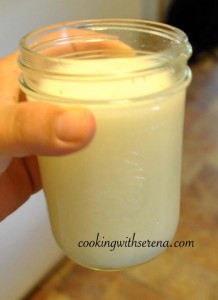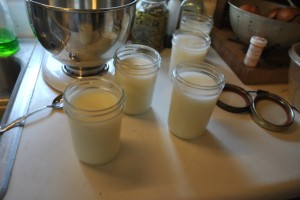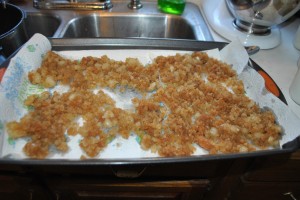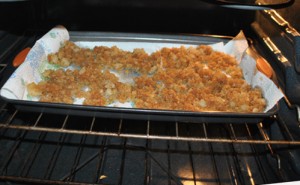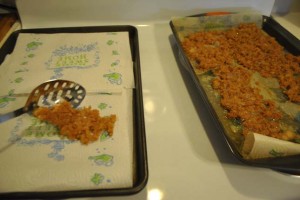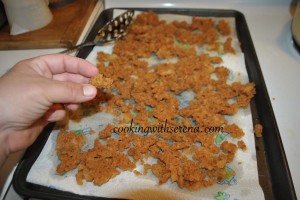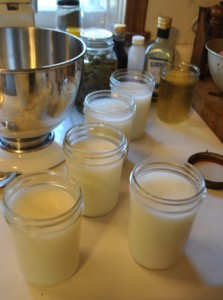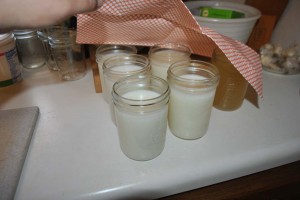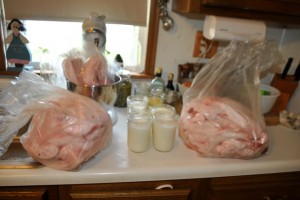HOW TO RENDER YOUR OWN LARD or MAKE YOUR OWN TALLOW
How to Render Your Own Lard or Make your Own Tallow
or to “try out” your fat as the old timers used to say
So today I was very blessed by my church friends Christina and Gary. Gary not only works in the coal mines but he also is a small home farmer. He has pigs, horses, and cattle.. to name but a few of his animals. Gary had two of his hogs slaughtered and asked if we would like some of the fat.. of course we were thrilled.
We went today and picked up what we weighed in to be right at 40 pounds of pork fat.
NOTE: Lard is made from Pork Fat
You can ALSO make TALLOW the same way you make Lard, only instead of pork you are rendering the suet of Goat, Beef, Venison, Sheep and such
NOTE: Tallow is the rendered fat of cows, sheep, and other “ruminant” animals such as deer.
ruminant- is animal that is known as chewing the cud Dictionary meaning– mammal that digests plant-based food by initially softening it within the animal’s first compartment of the stomach principally through bacterial actions, then regurgitating the semi-digested mass, now known as cud, and chewing it again. The process of rechewing the cud to further break down plant matter and stimulate digestion is called “ruminating”
- To make Lard from Pork, or Tallow from Ruminant Animals such as deer you will need to do a process called Rendering
Rendering is the process of gently heating the interior fat tissue, called “suet,” causing the pure oils to melt away from the rest of the tissue.
So I got 14 pounds I am working with tonight.. the rest is in the fridge I will work it up tomorrow and the next day as I have time.. I could also put those other bags in the freezer if I didn’t want to fool with them right now and they would be just fine.. pork fat does great in the freezer. But I am hopefully going to get it all tackled and over and done with, Jared and Sealed before too long so I can move on to my apples. So I got mine stored in the fridge for now as I am working it up..
Now there are three types of pork fat that come from a pig.. and even if you get it all mixed together like mine was… you can still tell pretty much what is what.. the really soft clean fat is the best it is leaf lard..from the innards of the pig,it is the cleanest and most odorless fat from the pig. Usually used for pastries and making pure white lye soaps.
the tough thick fat that you may have to watch for hairs here and there is fat back it may still have meat even attached, great for frying with. A very savory fat. It comes from the shoulders, rump and back of the pig.
and of course you have the pork belly fat soft and firm, that has meat intertwined. It is the fat used to cure bacon with.
We will be using ALL of our fat we got to render lard..
First you want to cut your fat into strips and then chunk it (I will be putting mine in my heavy duty food processor a little at a time to get mine very soft so I can render mine down easier)
You can sometimes get your butcher to run it through his grinder and have it that way already if you remember to ask. Or you can just cut it up really small and start out that way and skip all the cutting and grinding or processing ect.. I don’t reccomend you to use larger chunks it will take quite a while because you will be cooking it down on very low heat. if you do not have a heavy duty processor or food grinder cut your chunks up very small with knife like so
Like I said I am going to put a little at a time that I chunked up into my Heavy Duty Food Processor.. you need a strong one or you will burn up your motor so do not try it if you don’t have a good one.. you will get a LOT more lard out of your fat if you have it minced up smaller and you will save time, because it NEEDS to be cooked low and slow in order to get the purest white.
Now I am ready for my crock pot (you can cook on stove as well but I find it easier to do in the crock with lid OFF) LOW AND SLOW don’t get in a hurry
HOW LONG SHOULD I COOKI IT? YOU ASK
- On the stove you would maybe take about 2-3 hours depending on size of your fat and how much you are rendering..
- In crock pot with LID OFF about 5 -12 hours, depending on size of your fat you cut up and again HOW MUCH you have to render.if you were doing just a little bit you may only be 3 hrs., I of course have 14 pounds of it in my first batch tonight and even though mine is ground down, that is going to take quite some time at this low heat.. I don’t want to cook it too high just to get it done faster because it will change the color of my lard and make it yellow.. I want to cook it low and slow careful not to burn by coming back to stir every hour or so..
Started at 12 pm tonight in the crock pot with lid off instead of stove this time so I can turn to warm and just go to bed if I get tired of waiting… I am a night owl so I would rather do it while I do laundry anyways..
mine was ground up so I will check mine in about an hour . You will put 1/2 cup or a little more (according to how full your pot is) of water, so it wont stick while cooking.. don’t worry the water will be gone and evaporate out as you cook it.
add your fat
in about an hour if yours was put in ground fine and not in big ole chunks, it should be starting to separate from the cracklins.. you can see the liquid coming up and the fat balls nubbing up ..
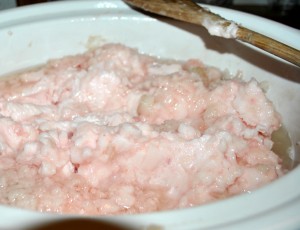 notice it start to melt and separate
notice it start to melt and separate
3 am (3 hours later) and it is looking like little mushy pebbles and a lot more juicy. .. there is a slight smell in the air, not bad at all, just smells like someone had been cooking, just mild scent.
5 am I am ready for my first rendering.. this should be my white lard for pastry making and soap if I decide to use it for that later…… You will use a sieve and cheesecloth or thin muslin to strain off over top a pot then push down to get out any extra oil..
then you will return your cracklins to the crock pot or stove top..
 you now will take this oil and run it through another strainer to catch all bits and pieces into your wide mouth jar suitable for freezing or canning or a plastic container that has a lid that you can use for freezing.
you now will take this oil and run it through another strainer to catch all bits and pieces into your wide mouth jar suitable for freezing or canning or a plastic container that has a lid that you can use for freezing.
My FIRST rendering I Made 3 full size pint jars.. now the rest will cook down , you do the same process, as you continue cooking and rendering you may see changes in color in your jars you render or as the old folks called it “try out”. Some may be darker so keep track of the ORDER of your renderings although you can usually tell visually..
Note: when rendering you may end up with different colors but that is fine.. the snow white which is the best for your pastries comes from your first rendering,
where you strain off the chunks of fat using a sieve or colander, lined with cheesecloth, then take your chunks of fat and add back to pot and keep cooking it down and you will soon have your second rendering which may come out a little darker tinted.. some of the cracklins will settle to the bottom and at this point your second rendering is done.. the last renderings will be most flavored and used for cooking and frying the first will be the whitest and cleanest and used for soaps and making pastries .
you will save all your fat in the end.. that is your CRACKLINGS.. Usually your cracklins are still fatty and soft not crisp like bacon yet, you simply put on paper towel lined cookie sheet spread out evenly
and put in oven at 375 for 25 minutes or till crisp or you can cook over heat in pan or pot till crisp like you would bacon..
drain it off on paper towels and you have cracklins for cornbread or bacon bits for salad, potato soup toppings ect.. good stuff!!!!
Let your cracklins completely cool and drain off dry before you try to put into freezer bags or jelly jars to freeze
Now to preserve my lard. I can do three things. I can put some in the fridge which will last me about 3 months. I can freeze it in wide mouth canning jars or plastic containers. or I can CAN it.. but that is at your own risk, it is NOT USDA approved.. although people have been doing it for years and years and years. I must still tell you that it is not USDA approved. But you yes you can, CAN it and if you do, use a pressure canner.
Let your lard cool before you put on lids, and remember the order you rendered them in.. notice the jar in the back that I just got out of my last rendering before the cracklins were done… now it takes quite a while for these to solidify so do not move or mess with them until they solidify..
Once they solidify, let them cool overnight before freezing.
you can put a cheesecloth or paper towels over top to keep clean until ready to put lids on
Get them out as needed and let defrost for soap making.
Put a jar for baking with in the refrigerator.
Now as for me.. I got to get back to work.. I still got a ton of lard to render, started with 40 pounds and I only got one 14 pound bag done
14 lbs fat = 6 full pint jars Lard
Categories
- ***SERENA'S FAVORITES (848)
- *POETRY BY SERENA* (14)
- *TRIED AND TRUE RECIPES-FACEBOOK GROUP FOOD DISCUSSIONS WORTH KEEPING LOL (105)
- *VIDEOS (12)
- AISIAN STYLE/CHINESE/ JAPANESE/ KOREAN/THAI (50)
- AMISH & MENNONITE RECIPES (64)
- ANTIQUE RECIPES (338)
- ANYTHING ITALIAN/PASTA DISHES ECT (211)
- APPETIZERS/SNACKS/DIPS (343)
- BABY FOODS/IDEAS (1)
- BBQ (72)
- BEEF (245)
- BEVERAGES/NON ALCOHOLIC PLEASE (65)
- BIRTHDAY IDEAS (50)
- BLENDER/FOOD PROCESSOR RECIPES (5)
- BORROWED RECIPES FROM THE WEB (103)
- BRAZILLIAN (1)
- BREADS/PASTRIES (339)
- BREAKFAST/BRUNCH (222)
- BROWNIES (80)
- BUTTER (8)
- CAKE ICINGS /FROSTING/ FILLINGS (159)
- CAKE MIX RECIPES (155)
- CAKES (586)
- CAMPFIRE COOKING/OUTDOOR (18)
- CANDY/FUDGE/ POPCORN BALLS (249)
- CANNING/PRESERVING/TIPS (234)
- CASSEROLES (205)
- CAST IRON COOKING (102)
- CHEESE (78)
- CHEESECAKES (87)
- CHICKEN/TURKEY * POULTRY* (358)
- CHRISTMAS (348)
- COBBLERS/DESSERTS/ PUDDINGS (271)
- COOKIES/BARS (359)
- COOKING FOR LARGE GROUPS (50)
- CORNBREAD (50)
- CRAFT IDEAS AND PHOTOS (64)
- CREATIONS (174)
- CROCK-POT/SLOW COOKER (161)
- CUPCAKES (76)
- CURRIES (1)
- DAIRY FREE (8)
- DECORATING FOOD TIPS (26)
- DIABETIC/SUGAR FREE (27)
- DRIED MEATS, FRUITS, HERBS- & Recipes using dried foods (25)
- DUMPLING RECIPES (32)
- EASTER (83)
- EGG RECIPES (61)
- EGGLESS RECIPES (4)
- FALL/HALLOWEEN (124)
- FAVORITE KITCHEN EQUIPMENT/ ACCESSORIES (18)
- FISH/SEAFOOD ECT… (109)
- FLOPS/ & CREATIVE USES (2)
- FOOD ALLERGIES? (3)
- FOOD ART (7)
- FREEZING FOODS (60)
- FRIED FOODS (99)
- FRUIT RECIPES (175)
- GARDENING TIPS AND PHOTOS HERE (61)
- GERMAN (14)
- GLUTEN FREE (20)
- GOAT (1)
- GRAVIES/SAUCES (12)
- GRILLING OUT/PICNIC FOOD IDEAS (78)
- HITS (56)
- HOUSEHOLD RECIPES/ HOME REMEDIES (94)
- HOW TO…. (92)
- HUNGARIAN RECIPES (2)
- I LEARNED THE HARD WAY NOT TO….. (20)
- ICE CREAM MACHINE RECIPES (4)
- ICE CREAM/SHERBERTS & TOPPINGS (60)
- INDIAN CUISINE (5)
- INTERNATIONAL (47)
- IRISH (8)
- JAMAICAN (3)
- JUICING/SMOOTHIES (11)
- KIDS RECIPES (215)
- LAMB/MUTTON (9)
- LEFTOVERS (63)
- LIVER RECIPES (4)
- LOW CARB (30)
- LOW CHOLESTEROL (15)
- LOW FAT/DIET (183)
- MALAYSIAN/NYONA (4)
- MEASUREMENT CHARTS (4)
- MEXICAN/SOUTH OF THE BORDER (143)
- MICROWAVE COOKING (30)
- MISCELLANEOUS (37)
- MOM ON THE GO (120)
- MONGOLIAN (2)
- MUFFINS (57)
- MUST HAVES FOR THE PANTRY/STAPLES (1)
- NAVAJO/AMERICAN INDIAN (4)
- NO BAKE RECIPES (39)
- ORGANIC COOKING (17)
- PARTY PLEASERS/SHOWERS ECT… (139)
- PASTA DOUGH RECIPES (8)
- PEANUT BUTTER/NUTELLA (72)
- PERUVIAN (4)
- PESTO (5)
- PET RECIPES/ TIPS (8)
- PHILIPPINE DISHES (2)
- PICTURES YOU WANT TO SHARE (172)
- PIES/TARTS (298)
- PIZZA (87)
- POLISH (1)
- PORK (168)
- POTATOES (181)
- PRESSURE COOKER (31)
- PUFF PASTRY /PHYLLO DOUGH RECIPES (16)
- RAMP RECIPES (2)
- RANDOM BLOGGING (39)
- RECIPES IN A JAR/GIFT GIVING IDEAS (19)
- RECIPES TO LIVE BY (14)
- RESTAURANT RECIPES (82)
- RICE RECIPES (99)
- ROASTER IDEAS (1)
- SALAD DRESSINGS (11)
- SALADS/GREENS (69)
- SANDWICHES/BURGERS/SPREADS (78)
- SAUSAGE/KIELBASA RECIPES (23)
- SCHOOL STUFF (8)
- SCRATCH MIXES /CANNED GOODS (34)
- SEASONINGS/SPICES/RUBS (17)
- SEMI HOMEMADE/TRICKS/QUICK N EASY (192)
- SIDES/VEGGIES (243)
- SMOKER (3)
- SOUFFLE'S (4)
- SOUL FOOD/CREOLE (46)
- SOUPS/CHILIES & BEANS /CHOWDERS (263)
- SPANISH (3)
- ST. PATTY'S DAY (31)
- STUFFING/DRESSINGS/STUFFED FOODS (38)
- SUBSTITUTIONS (44)
- SUNDAY SCHOOL CRAFTS IDEAS AND FOOD (103)
- THANKSGIVING FAVORITES (131)
- TIPS FOR THE COOK (107)
- Uncategorized (2)
- VALENTINE IDEAS RECIPES /ROMANTIC/ RECIPES FOR 2 (53)
- VEGETARIAN/VEGAN (87)
- WAITING TO BE MADE (REMINDER) (74)
- WEDDING IDEAS (3)
- WILD GAME & WV TRADITIONS (147)
- ZUCCHINI & YELLOW SQUASH RECIPES (72)



